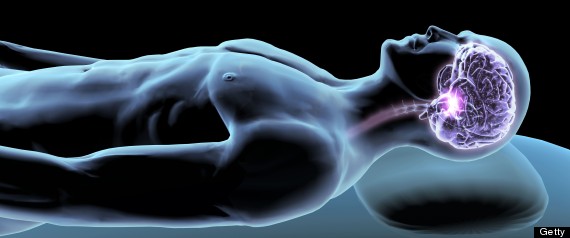Tagged: Alzheimer’s disease
New Blood Test Can Predict Alzheimer’s Disease
For years doctors have been able to detect the early symptoms of Alzheimer’s disease through scans, lumbar punctures, and genetic testing. While these methods can be painful or expensive, a new blood test has recently been discovered that can easily and accurately predict the onset of Alzheimer’s disease.
Doctor Howard J. Federoff of Georgetown University Medical Center conducted a research study in which he took blood samples from hundreds of healthy, elderly men and women over the age of 70. Over the next five years, some of these healthy individuals developed Mild Cognitive Impairment or Alzheimer’s Disease. Federoff then compared their blood samples to the samples of the healthy individuals. He found a group of ten lipids, or fats, that were present in lower amounts in the blood samples of the participants who had developed Alzheimer’s Disease.
Why do we need sleep?

We know from everyday life that, at some point, we need to sleep. In fact, extended sleep deprivation can lead to death. Despite the amount of sleep research that has been conducted, none have been able to clearly reason out the essential function of sleep. However, recently, a promising study by Dr. Nedergaard showed that sleep functions in clearing neurotoxic waste from the brain of mice. In effect, without sleep, these toxins would build up and cause problems for the body.
Specifically, the study looked at what is known as the glymphatic system. Because our central nervous system lacks a lymphatic system which is in our peripheral system, the glymphatic clearance pathway is the primary way in which our brain can "clear" the cerebrospinal fluid (CSF) and interstital fluid (ISF) of the brain parenchyma. This clearance includes functions of getting rid of wastes, soluble proteins, and even controlling the volume of fluid. Interestingly, the Nedergaard study showed that this clearance system works faster when mice were asleep--in other words, the exchange rates of CSF and ISF increased during sleep. In addition, they were able to show that surrounding cells in the brain would shrink in size to allow more efficient clearance.
The Effects of Stress on Memory Loss
 Stressed out? You may be at a higher risk for Alzheimer's disease. You're probably wondering to yourself how that is possible. Highly intelligent people who use their brains all of the time, like scientists, CEOs, and presidents, deal with stress on a day to day basis. The truth is that lack of higher education or brain activity is not the only major cause of dementia.
Stressed out? You may be at a higher risk for Alzheimer's disease. You're probably wondering to yourself how that is possible. Highly intelligent people who use their brains all of the time, like scientists, CEOs, and presidents, deal with stress on a day to day basis. The truth is that lack of higher education or brain activity is not the only major cause of dementia.
If keeping your brain active is a good way to prevent cognitive decline, then why did people such as Ronald Reagan and Norman Rockwell develop Alzheimer’s disease? The answer is stress. Recent studies have shown that people who deal with high levels of stress in their career or their family life are more likely to develop dementia. Stress cannot be said to directly cause dementia, but it is a trigger for the degenerative process in the brain.
An Argentine research team examined 118 patients with Alzheimer’s disease and 81 healthy individuals whose age, gender, and educational level were comparable to the Alzheimer's patients. Both groups were questioned about the amount of stress that they had faced in the past three years. The researchers reported that 72% of the Alzheimer’s patients admitted to coping with severe emotional stress or grief, such as the death of a loved one or financial problems. This was nearly three times as many as the control group.
A Peek at Parkinson’s: What’s New for the Old?
With the Pancakes for Parkinson’s event at Boston University nearing, on April 2nd, I thought it would be a good time to check up on the latest in Parkinson’s research.
Firstly, Parkinson’s Disease (PD) is a motor disorder that affects dopaminergic neurons of the brain, which are necessary in the coordination of movement. Onset is usually around age 60, starting with symptoms including tremor, stiffness, slowness of movement, and poor balance and coordination. While current treatments can help alleviate the symptoms in patients, none provide a cure.
Second off, the mission of the Michael J. Fox Foundation for Parkinson’s Research and other support groups is to find better treatments for those suffering from the disease. With the Baby Boomer generation entering late adulthood and old age, more research needs to be done to better understand the disease and help those with it find relief. Consider stopping by the GSU Alley for some pancakes to show your support for the Foundation and its cause next month!
Ranging from studying food intake to using technology, many approaches have been used in PD research. More
The Cost of Dementia
When a neuroscientist is asked about Alzheimer’s research, some of the first things that may come to mind are genetic predispositions, amyloid plaques, and tau proteins. One may think of researchers in labs running experiments on cultures of cells, or slice studies from brains of those affected with the disease. However, there is a whole other world of research being conducted on Alzheimer’s that I’m sure escapes many scientists’ minds. More
“Could I ask everyone to please take their seat? The Memory Ensemble will begin momentarily.”

If I told you that a theater company and a medical school collaborated to produce one of the best plays of the year, would you believe me?
Probably not, because this is not the case. However, this unlikely partnership of industries did produce a substantial therapeutic program for people who are currently suffering the cognitive deficits associated with dementia.
Based on the theory of cognitive reserve - or the brain’s resilience to neuropathological damage - it is widely hypothesized that creative and interactive activities, such as painting, singing, and acting, would help patients maintain their cognitive functions for as long as possible.
With this hypothesis and the guidance of the Lookingglass Theater Company, the Feinberg School of Medicine at Northwestern University formed the first-ever "Memory Ensemble." The cast included six elderly patients suffering from early stages of memory loss, a common symptom attributable to various types of dementia.
Quoted as “one of the first-of-its-kind," the directors of this production sought to design a program that would improve the quality of life for these patients by setting up a safe and supportive environment. With the serene scene set, patients were encouraged to express every emotion and/or words associated with their neurological deficits to help them alleviate any pains or questions of uncertainty accompanied by these disorders.
As a part of a seven week pilot study, the ensemble would meet and participate in various cognitive activities, including an impromptu-style of acting that actively engaged the patients both physically and mentally. As a baseline measure, metaphor-based warm-up exercises prompted the patients to choose a color that symbolizes their current emotional state. Prior to their regularly scheduled regime, the patient’s reports ranged from a happy sunny yellow to a melancholy blue. Nevertheless, after a stretching routine, body-sculpting exercises portraying various feelings, and an active discussion of the hardships involved with their disorders, all of the patients were quick to describe their emotional state at the end of the workshop as a happy yellow.
Although these patients verbally reported an improvement in their quality of life within the given time period, it was noted that this qualitative research study could not quantitatively provide evidence in support of their hypothesis. Thus, a lack of evidence from this study could be detrimental to implementing this therapeutic program in hospitals across the US simply because of the lack of funding.
Though not discussed in this article, pre- and post-study fMRI scans and intermittent neuropsychological tests could provide quantitative insight on whether or not such a therapeutic program significantly contributes to the patient’s cognitive reserve. Pre- and post-study fMRI scans of the patients performing these neuropsychological tests can be compared to control subjects, as well as across-patients and within-patients, in order to identify the statistical differences between the patterns of activity associated with each task. Other measures, such as reaction time, can also be recorded to correlate with the patients behavioral performance to provide more information and insight on whether or not this is an effective prevention program.
Despite this predicament, I must say that I am very impressed and optimistic about this new style of therapy because it helps the patient positively cope with such a disastrous and unfortunate mental disorder. In the future, I hope that quantitative measures, as discussed before, will be implemented to help facilitate and disambiguate the uncertainty pertaining to dementia-related research.
Trying Improv as Therapy for Those with Memory Loss - Chicago News Cooperative - NYTimes.com
Cognitive Reserve - Dr. Yaakov Stern (2009) - Neuropsychologia (PDF)
Forget Me Not

Do you ever fear that you are losing your memory?
One hundred years ago, when Alzheimer's Disease (AD) was even more of a mystery than it is now, amyloid protein aggregates were described as black spots that showed up on brain slices after autopsy. These aggregates, commonly known as plaques, denote the telltale sign that a patient has AD. Until recently, these plaques could only be detected after death, but Dr. Daniel Skovronsky, creator of Avid Radiopharmaceuticals, may have a solution.
On July 11th, Dr. Skovronsky will present his latest findings at the international meeting of the Alzheimer's Association in Honolulu. He has spent the last five years creating a fluorine radioactive dye to be used in positron emission tomography (PET) scans. The results of these PET scans are engineered to be so accurate that they can compete with brain autopsies, the only method currently available to determine whether a patient has AD.
The Food and Drug Administration (FDA) questioned Dr. Skovronsky about his fluorine-18 dye and whether the results of fluorine-18 PET scans compare to the definitive results of brain autopsies. Dr. Skovronsky recruited thirty-five patients in hospice with ranging levels of memory loss; all of these patients would receive a PET scan and would have their brains autopsied post-mortem. The results of each patient's PET scan matched his or her autopsy results.
If approved by the FDA, Dr. Skovronsky's work will lead to an increase in accuracy in the diagnosis of Alzheimer's disease. Currently, 20% of patients diagnosed with AD are revealed to not have the disease when an autopsy is performed. With fluorine-18, Dr. Skovronsky has fine-tuned a method to detect amyloid plaques in the brain in a living patient, which is a feat within itself. Previously, the only way one could determine whether a patient had the disease or not was through autopsy - a posthumous procedure. Now, patients could have the chance to receive an accurate diagnosis while they are still alive and earlier in their lives.
In addition to simply detecting plaque, fluorine-18 will also aid in understanding the development of the disease, for plaques were found in patients deemed as healthy when they took memory tests. Currently, people who are not diagnosed with AD earlier in life will not receive treatment until the disease has developed more, and they will likely not receive any preventative medicine. With Dr. Skovronsky's PET scans, doctors could diagnose the development of the disease earlier and administer preventative measures to slow down the development of the disease. Also, patients who are currently misdiagnosed with AD do not receive the correct treatments that they need for the diseases that are actually causing their memory loss or dementia, like depression.
The Vanishing Mind - Promise Seen for Detection of Alzheimer's - NYTimes
The Alzheimer's Disease Neuroimaging Initiative positron emission tomography core - Alzheimer's Dement. 2010
In Vivo Imaging of Amyloid Deposition in Alzheimer Disease Using the Radioligand 18F-AV-45 (Flobetapir F 18) - The Journal of Nuclear Medicine
